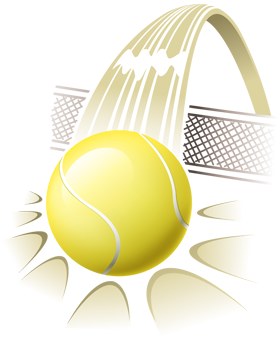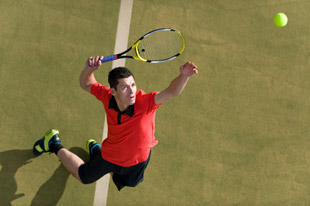MARCH, 2012:
BENDING THE SERVE IN
 Learning this skill is exactly where many club players, even aspiring higher ones, stall-out, and their serve literally flat-lines permanently. Very limiting.
Learning this skill is exactly where many club players, even aspiring higher ones, stall-out, and their serve literally flat-lines permanently. Very limiting.
If you’re still one of those players who serves exclusively flat on 1st serve after playing for a few years or more, and you tentatively tap in your 2nd serve meekly without any spin – advantage receiver, it’s well past the time you should learn to bend-it-in.
Long ago, or if you’re relatively new to the game, you settled on a serving grip that either is or closely resembles your forehand grip. It’s a grip that on serve squares the face of the racket to the ball at impact. This results in imparting little spin to assist gravity in bringing the ball down – when the air pressure above the ball becomes enhanced with the ball rotating 15 to 20 to 25 times per second - into a relatively small service box that’s in close proximity to the net barrier. Not much margin for error available there for a ball struck flat with pace but lacking rotation.
That means the viable pass-through-space immediately above the net is very small and unforgiving on a first serve, and then, as a result of a typically low 1st serve percentage among these players, promotes the “chicken-little” puff-ball, fluff-a-nutter second serve which should be reserved for beginners and novices only!
Here’s how you can graduate to spin in one practice session completely by yourself. Whatever your existing flat serve grip currently is rotate the racket in your hand 1/16th to 1/8th of an inch to the right. Voila. This will create a slightly – all that’s needed - angular racket face at impact causing the ball to rotate through the air and give gravity a boost.
Bend it like Beckham! Different sport same goal.
You will immediately see a change in the ball’s in-flight trajectory from the previous laser beam like flight to one that slightly curves right to left and arcs downward as well. Just visualize those great graphics utilized by the Hawkeye line calling replay technology that’s now commonplace in televised tennis. That’s what you’re visualizing.
In the beginning stages of its development, the ball will go left of the intended target and into the net. This will necessitate literally aiming “wrong” – over compensating by visualizing the target being to right of the actual intended target and by aiming considerably higher over the net than previously – until the neuromuscular magic has a chance to adapt. Your brain is smarter than you are. Let it happen.
Once settled-in you can begin to alter your toss, and possibly your grip still further, to gain either more “rainbow” trajectory – the bending spin serve, or greater right-to-left movement with reduced arc – a slice or slider, or a combo platter of the two. A useful rule of thumb regarding toss location to achieve placement in the box is: left creates right, right creates left. Placing your toss both closer to you and to the left will force you to “hit-up” on the ball at approximately the 1:00 side of the ball (seemingly over), while to the right, yet still in front like a “flattie” toss will allow you to hit more “around” the 2:00 side of the ball.
 This will require some solitary practice time – fun to me! But players often fall short on this necessity and then complicate matters by prematurely introducing their new bender or slice exclusively on second serve. Yup, you guessed it, the double faults come in bunches and the technique is quickly abandoned as undoable and impractical. And the giving-up on it begins.
This will require some solitary practice time – fun to me! But players often fall short on this necessity and then complicate matters by prematurely introducing their new bender or slice exclusively on second serve. Yup, you guessed it, the double faults come in bunches and the technique is quickly abandoned as undoable and impractical. And the giving-up on it begins.
When first unveiling it – in a friendly! – use the technique on 1st serve only. The pressures off and you can swing freely and begin to create a new muscle memory. The percentages will eventually come up a bit and, on 2nd serve, you can still get the ball in play just as you have previously.
In time, again with practice, your success on 1st serve will improve dramatically, at which time you can then begin to use your new bender-slice appropriately in 2nd serve situations and go back to your “big” 1st serve and live happily ever after.
Maintaining the same racket head speed utilized on a 1st serve is crucial when learning to spin-bend-slice the ball in on the 2nd. This will create greater ball rotation to clear the net safely and bring the ball into the service box, not to mention unconflicted muscle memory.
Remember what tennis legend and founder of the pro tours as we know them today Jack Kramer said, which rings absolutely true: “You’re only as good as your 2nd serve.” So learn an effective one with spin.
Questions and comments are welcome at anytime for all tips present and past via email.
This Tip of the Month is copyright© by Jak Beardsworth Tennis. All rights reserved. Copies may be made only with the permission of and by Jak Beardsworth. Contact him here.
Tips Archive
- May, June, 2013 JUST TALKING HEADS OR MORE [read more]
- March, April, 2013 SELF-TALK: Good, Bad, or Indifferent [read more]
- January, February, 2013 BOOK-A-MILLION: Do Tennis Players Read? [read more]
- December, 2012 THE KEY TO TOUR LEVEL BALL STRIKING: And How to Learn It [read more]
- November, 2012 ARE YOU A THUDDER, A TWANGER, OR A PINGER: Racket Dampeners [read more]
- September, October, 2012 SMART SHOTS [read more]
- July, August, 2012 TEN TOP STRESS REDUCERS [read more]
- June, 2012 MAKING YOUR LESSONS STICK [read more]
- May, 2012 THE IMPOSSIBLE: Accelerating and Decelerating Simultaneously [read more]
- April, 2012 PLAYER DISCONNECTION [read more]
- March, 2012 BENDING THE SERVE IN [read more]
- February, 2012 UNDERSTANDING TERMINOLOGY: Drill vs Clinic vs Team Practice [read more]
- January, 2012 PLAYING SCARED? [read more]
- December, 2011 CUTTING OFF THE ANGLE…VERTICALLY [read more]
- November, 2011 WHY COACHING? [read more]
- October, 2011 THE EASY BALLS ARE NOT EASY [read more]
- August/September, 2011 NEVER TOO LATE FOR OLDER DOGS [read more]
- June/July, 2011 HARD COURTS, SOFT COURTS, and YOUR BODY'S ADAPTATION [read more]
- April/May, 2011 JAW DROPPNG [read more]
- March, 2011 CLUB DOUBLES' INCREASINGLY MISSING LINK [read more]
- February, 2011 TIP 2 | POOH POOHING DOUBLES STRATEGY SESSIONS [read more]
- February, 2011 TIP 1 | CLAY TO HARD, HARD TO CLAY [read more]
- January, 2011 ICING THE SERVER WHEN RECEIVING IN THE BIG MOMENTS [read more]
- December, 2010 JOHN ISNER’S “GOOD MISS” [read more]
- November, 2010 THE MOST NEGLECTED SHOT IN THE GAME [read more]
- October, 2010 BALL BOUNCING and the SERVE [read more]
- September, 2010 TAKE YOUR EYE OFF THE BALL [read more]
- July-August, 2010 SUMMER SCHOOL COURTSIDE CRIB SHEET [read more]
- May-June, 2010 THE 2-HANDED JUMP BACKHAND: The Dumbest Shot in Tennis [read more]
- April, 2010 THE STANDING AROUND SYNDROME [read more]
- March, 2010 THE ELUSIVE SERVICE TOSS [read more]
- February, 2010 PREPARING TO START THE POINT: Serving and Receiving [read more]
- January, 2010 DEBUNKING THE MODERN GAME [read more]
- December, 2009 RELAX – IT'S JUST A RALLY BALL [read more]
- November, 2009 DEFEATING THE POACHER [read more]
- October, 2009 PRACTICE, PRACTICE, PRACTICE [read more]
- September, 2009 SERVING SUCCESS: Warming-Up vs Match Play [read more]
- August, 2009 THE SPLIT STEP: Defending the Court, Rushing the Net, and More [read more]
- July, 2009 THE THIRD GROUNDSTROKE [read more]
- June, 2009 HOW MANY HANDS DOES IT TAKE? [read more]
- May, 2009 THE MOST IMPORTANT SKILL [read more]
- April, 2009 PLAYING IN THE FLORIDA WIND [read more]
- March, 2009 Letting them Play for Peak Performance in Clubland [read more]
- February, 2009 SUPPORTING YOUR GAME [read more]
- January, 2009 RESPECTING THE GAME: Top 10 Do's & Don'ts [read more]
- December, 2008 Getting the Warm-up Right [read more]
- November, 2008 Visualize...Realize: The Mind Body Connection [read more]
- October, 2008 Reading Their Mail [read more]


